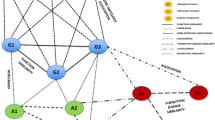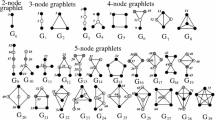Abstract
Biological networks are used to describe molecular machineries within cells. Therefore, the comparison among networks of different species or different states (e.g., healthy vs diseased people) may reveal relevant knowledge such as information about evolution. Comparison among networks is usually performed using network alignment algorithms. In a previous work, we used global network alignment to produce prior knowledge about networks that has been used on local network alignment algorithm. Here, we present Simulated Annealing-Global Local Aligner (SL-GLAlign), a novel framework methodology based on the use of topological information extracted from global alignment to guide the building of local alignment. To assess our methodology, we tested SL-GLAlign on several biological networks. Comparing with the state-of-the-art local alignment algorithms, SL-GLAlign is able to improve the alignment building.









Similar content being viewed by others
References
Brown KR, Jurisica I (2005) Online predicted human interaction database. Bioinformatics 21(9):2076–2082
Cannataro M, Guzzi PH (2012) Data management of protein interaction networks. Wiley, New York
Cannataro M, Guzzi PH, Veltri P (2010) Protein-to-protein interactions. ACM Comput Surv 43(1):1–36
Ciriello G, Mina M, Guzzi PH, Cannataro M, Guerra C (2012) Alignnemo: a local network alignment method to integrate homology and topology. PLoS One 7(6):e38107
Enright AJ, Van Dongen S, Ouzounis CA (2002) An efficient algorithm for large-scale detection of protein families. Nucleic Acids Res 30(7):1575–1584
Faisal FE, Zhao H, Milenković T (2015) Global network alignment in the context of aging. IEEE/ACM Trans Comput Biol Bioinform 12(1):40–52
Fornito A, Zalesky A, Breakspear M (2013) Graph analysis of the human connectome: promise, progress, and pitfalls. Neuroimage 80:426–444
Guzzi PH, Cannataro M (2010) \(\mu\)-CS: an extension of the TM4 platform to manage Affymetrix binary data. BMC Bioinform 11:315
Guzzi PH, Milenković T (2017) Survey of local and global biological network alignment: the need to reconcile the two sides of the same coin. Brief Bioinform 19:472–481
Harispe S, Ranwez S, Janaqi S, Montmain J (2014) The semantic measures library and toolkit: fast computation of semantic similarity and relatedness using biomedical ontologies. Bioinformatics 30(5):740–742
Hirsh E, Sharan R (2007) Identification of conserved protein complexes based on a model of protein network evolution. Bioinformatics 23(2):e170–176
Hu Y, Flockhart I, Vinayagam A, Bergwitz C, Berger B, Perrimon N, Mohr SE (2011) An integrative approach to ortholog prediction for disease-focused and other functional studies. BMC Bioinform 12(1):357
Ibragimov R, Malek M, Guo J, Baumbach J (2013) GEDEVO: an evolutionary graph edit distance algorithm for biological network alignment. In: OASIcs openaccess series in informatics, vol 34, pp 68–79
Kuchaiev O, Pržulj N (2011) Integrative network alignment reveals large regions of global network similarity in yeast and human. Bioinformatics 27(10):1390–1396
Malod-Dognin N, Przulj N (2015) L-graal: Lagrangian graphlet-based network aligner. Bioinformatics 31:2182–2189
Mamano N, Hayes W (2016) Sana: simulated annealing network alignment applied to biological networks. arXiv preprint arXiv:1607.02642
Meng L, Striegel A, Milenkovic T (2015) Local versus global biological network alignment. arXiv preprint arXiv:1509.08524
Milano M, Guzzi PH, Tymofiyeva O, Xu D, Hess C, Veltri P, Cannataro M (2017) An extensive assessment of network alignment algorithms for comparison of brain connectomes. BMC Bioinform 18(6):31–45
Milano M, Guzzi PH, Cannataro M (2019) GLAlign: a novel algorithm for local network alignment. IEEE/ACM Trans Comput Biol Bioinform 16(6):1958–1969
Mina M, Guzzi PH (2012) Alignmcl: comparative analysis of protein interaction networks through Markov clustering. In: 2012 IEEE international conference on bioinformatics and biomedicine workshops (BIBMW). IEEE, pp 174–181
Mina M, Guzzi PH (2014) Improving the robustness of local network alignment: design and extensive assessmentof a markov clustering-based approach. IEEE/ACM Trans Comput Biol Bioinform 11(3):561–572
Nepusz T, Paccanaro A (2014) Structural pattern discovery in protein–protein interaction networks. In: Kasabov N (ed) Springer handbook of bio-/neuroinformatics. Springer handbooks. Springer, Berlin, Heidelberg, pp 375–398
Neyshabur B, Khadem A, Hashemifar S, Arab SS (2013) NETAL: a new graph-based method for global alignment of protein-protein interaction networks. Bioinformatics 29:1654–1662
Nooner KB, Colcombe S, Tobe R, Mennes M, Benedict M, Moreno A, Panek L, Brown S, Zavitz S, Li Q et al (2012) The nki-rockland sample: a model for accelerating the pace of discovery science in psychiatry. Front Neurosci 6:152
Pache RA, Aloy P (2012) A novel framework for the comparative analysis of biological networks. PLoS One 7:e31220
Patil A, Nakamura H (2005) Hint: a database of annotated protein–protein interactions and their homologs. Biophysics 1:21–24
Patro R, Kingsford C (2012) Global network alignment using multiscale spectral signatures. Bioinformatics 28(23):3105–3114
Resnik P et al (1999) Semantic similarity in a taxonomy: an information-based measure and its application to problems of ambiguity in natural language. J Artif Intell Res (JAIR) 11:95–130
Saraph V, Milenković T (2014) Magna: maximizing accuracy in global network alignment. Bioinformatics 30(20):2931–2940
Sarica A, Cerasa A, Vasta R, Perrotta P, Valentino P, Mangone G, Guzzi PH, Rocca F, Nonnis M, Cannataro M, Quattrone A (2014) Tractography in amyotrophic lateral sclerosis using a novel probabilistic tool: a study with tract-based reconstruction compared to voxel-based approach. J Neurosci Methods 224:79–87
Schaefer MH, Fontaine J-F, Vinayagam A, Porras P, Wanker EE, Andrade-Navarro MA (2012) Hippie: integrating protein interaction networks with experiment based quality scores. PLoS One 7(2):e31826
Sharan R, Ideker T (2016) Modeling cellular machinery through biological network comparison. Nat Biotechnol 24:427–433
Simonis N, Rual J-F, Carvunis A-R, Tasan M, Lemmens I, Hirozane-Kishikawa T, Hao T, Sahalie JM, Venkatesan K, Gebreab F et al (2009) Empirically controlled mapping of the caenorhabditis elegans protein–protein interactome network. Nat Methods 6(1):47–54
Sporns O, Tononi G, Kötter R (2005) The human connectome: a structural description of the human brain. PLoS Comput Biol 1(4):e42
Stelzl U, Worm U, Lalowski M, Haenig C, Brembeck FH, Goehler H, Stroedicke M, Zenkner M, Schoenherr A, Koeppen S et al (2005) A human protein–protein interaction network: a resource for annotating the proteome. Cell 122(6):957–968
Sun Y, Crawford J, Tang J, Milenkovic T (2015) Simultaneous optimization of both node and edge conservation in network alignment via WAVE. In: Pop M, Touzet H (eds) Algorithms in bioinformatics. WABI 2015. Lecture notes in computer science, vol 9289. Springer, Berlin, Heidelberg
Tymofiyeva O, Ziv E, Barkovich AJ, Hess CP, Xu D (2014) Brain without anatomy: construction and comparison of fully network-driven structural mri connectomes. PLoS One 9(5):e96196
Vijayan V, Saraph V, Milenković T (2015) Magna++: maximizing accuracy in global network alignment via both node and edge conservation. Bioinformatics 31(14):2409–2411
Xenarios I, Rice DW, Salwinski L, Baron MK, Marcotte EM, Eisenberg D (2000) Dip: the database of interacting proteins. Nucleic Acids Res 28(1):289–291
Yu J, Pacifico S, Liu G, Finley RL (2008) Droid: the drosophila interactions database, a comprehensive resource for annotated gene and protein interactions. BMC Genom 9(1):1
Funding
Pietro Hiram Guzzi has been partially funded by GNCS INDAM 2017 Grant.
Author information
Authors and Affiliations
Contributions
MM designed and implemented SL-GLAlign and performed all the tests. PHG leaded the software design and wrote the manuscript. PV contributed to the design of software and test. MC contributed to the writing of the manuscript and to the design of the tests. WH contributed to the design and implementation of the software and tests. All the authors read and approved the manuscript.
Corresponding author
Ethics declarations
Ethics approval and consent to participate
Not applicable.
Consent to publish
Not applicable.
Availability of data and materials
Data and supplementary materials are available at https://sites.google.com/view/sl-glalign/home.
Conflict of interest
Authors declare they have not competing interests.
Additional information
Publisher's Note
Springer Nature remains neutral with regard to jurisdictional claims in published maps and institutional affiliations.
Rights and permissions
About this article
Cite this article
Milano, M., Hayes, W., Veltri, P. et al. SL-GLAlign: improving local alignment of biological networks through simulated annealing. Netw Model Anal Health Inform Bioinforma 9, 10 (2020). https://doi.org/10.1007/s13721-019-0214-4
Received:
Revised:
Accepted:
Published:
DOI: https://doi.org/10.1007/s13721-019-0214-4




